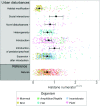Global urban signatures of phenotypic change in animal and plant populations
- PMID: 28049817
- PMCID: PMC5576774
- DOI: 10.1073/pnas.1606034114
Global urban signatures of phenotypic change in animal and plant populations
Abstract
Humans challenge the phenotypic, genetic, and cultural makeup of species by affecting the fitness landscapes on which they evolve. Recent studies show that cities might play a major role in contemporary evolution by accelerating phenotypic changes in wildlife, including animals, plants, fungi, and other organisms. Many studies of ecoevolutionary change have focused on anthropogenic drivers, but none of these studies has specifically examined the role that urbanization plays in ecoevolution or explicitly examined its mechanisms. This paper presents evidence on the mechanisms linking urban development patterns to rapid evolutionary changes for species that play important functional roles in communities and ecosystems. Through a metaanalysis of experimental and observational studies reporting more than 1,600 phenotypic changes in species across multiple regions, we ask whether we can discriminate an urban signature of phenotypic change beyond the established natural baselines and other anthropogenic signals. We then assess the relative impact of five types of urban disturbances including habitat modifications, biotic interactions, habitat heterogeneity, novel disturbances, and social interactions. Our study shows a clear urban signal; rates of phenotypic change are greater in urbanizing systems compared with natural and nonurban anthropogenic systems. By explicitly linking urban development to traits that affect ecosystem function, we can map potential ecoevolutionary implications of emerging patterns of urban agglomerations and uncover insights for maintaining key ecosystem functions upon which the sustainability of human well-being depends.
Keywords: anthropocene; ecoevolution; ecosystem function; sustainability; urbanization.
Conflict of interest statement
The authors declare no conflict of interest.
Figures



References
-
- Pimentel D. Animal population regulation by the genetic feed-back mechanism. Am Nat. 1961;95(881):65–79.
-
- Schoener TW. The newest synthesis: Understanding the interplay of evolutionary and ecological dynamics. Science. 2011;331(6016):426–429. - PubMed
-
- Matthews B, et al. Toward an integration of evolutionary biology and ecosystem science. Ecol Lett. 2011;14(7):690–701. - PubMed
Publication types
MeSH terms
LinkOut - more resources
Full Text Sources
Other Literature Sources

